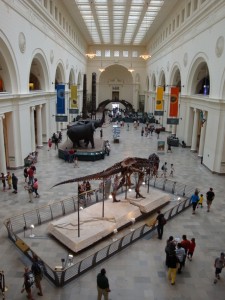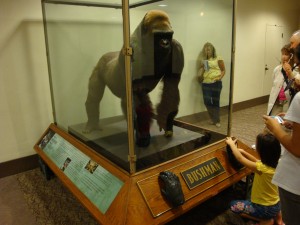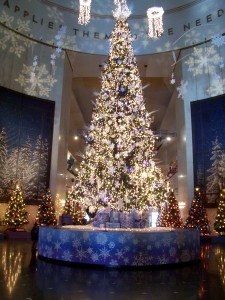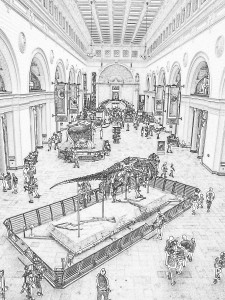
1. Where is this picture taken?
This picture is taken inside the great hall of a museum.
2. What do you see in the picture?
We see some displays, and people walking around.
3. How many displays are there in the great hall?
There are two displays visible in the great hall, a dinosaur skeleton, and an elephant diorama.
4. What type of museum do you think this is?
This museum is a natural history museum.
5. What other types of museums are there?
There are science museums, museums of art, music museums, cultural museums, lighthouse museums, living history museums, children’s museums (also called discovery museums or hands-on museums) and many other kinds.
6. What can you see at a museum?
At a museum you can see displays and exhibits.
7. What else might you see in a museum besides the exhibits?
You can also see models of things and stuffed animals, along with much more.
8. What kind of exhibits are in a museum only for a short time before they are sent to another museum?
Traveling exhibits are in a museum only for a short time, and then they are sent to another museum. It’s a way for museums to share their resources and allow many more people to enjoy the exhibits than would be possible if the exhibit stayed in only one place.
9. What kinds of people usually visit a museum?
Many people like to visit museums – school children, tourists, people who enjoy history, science, or culture.
10. What is a school trip to a museum called?
A school trip to a museum (or something similar) is called a field trip.
11. How can you get to the museum?
You can get to the museum by bus, train, taxi, car, or on foot.
12. What can you do with your car while you are at the museum?
If you drive your car, you can park your car in the parking lot. In some big cities, parking validation might be included in your admission.
13. What do you often need to get inside the museum?
To get inside the museum you usually need a ticket.
14. What kind of special deals are often available for admission?
There are often special deals on admission for school students, senior citizens, or groups of a minimum size. Sometimes museums will have free admission days, or discount days. Some museums have season passes which allow unlimited visits for the year. Some museums have reciprocal admission tickets, which will allow you to visit several museums in the city for one combined price.
15. If you leave the museum but want to come back the same day, how can you get back in?
If you want to leave the museum for some reason but are planning on coming back later that same day, you can have your hand stamped with a re-entry stamp.
16. How can you find your way around the museum?
You can find your way around the museum by using the museum map. You can also have a guide take you around the museum on a guided tour, or you can go on a self-guided tour.
17. What are the different parts of the museum called?
Off the great hall, or main hall, there are different wings of the museum.
18. Who works at a museum?
People who work at a museum would include the curator of the museum, the guides, the guards, the ticket takers, the people who run the museum shop, and the cafeteria workers.
19. Can you take pictures in a museum?
Some museums will let you take pictures, some will not. Some allow pictures, but prohibit flash photography.
20. What kinds of displays do they have at a children’s museum?
A children’s museum usually has many interactive, hands-on displays.
Paragraph: A Visit to the Museum
Chicago’s Museums
Chicago is home to a number of world-class museums. The most well-known of these are: the Field Museum of Natural History, the John G. Shedd Aquarium, the Adler Planetarium & Astronomy Museum, and the Museum of Science and Industry.
The Field Museum of Natural History
 This museum was originally called the Columbian Museum of Chicago, and it served to house many of the exhibitions and artifacts from the World’s Fair Columbian Exposition, which was held in Chicago in 1893 to mark the 400th anniversary of Columbus’ arrival in the New World. Later, the name was changed to its present form in honor of its first major benefactor, Marshall Field. The Field Museum has a number of popular displays: “Sue,” the most complete and best-preserved Tyrannosaurus Rex fossil thus far discovered; “Bushman,” a stuffed gorilla that originally lived in Chicago’s Lincoln Park Zoo and was renowned for his temper; the collection of mummies in the Museum’s “Inside Ancient Egypt” exhibition; and the numerous dinosaur skeletons in the exhibit “Evolving Planet.” Other permanent exhibits include the Grainger Hall of Gems, the Underground Adventure, the Ancient Americas, and Dioramas, as well as several working laboratories: the DNA Discovery Center, McDonald’s Fossil Prep Lab, and the Regenstein Laboratory.
This museum was originally called the Columbian Museum of Chicago, and it served to house many of the exhibitions and artifacts from the World’s Fair Columbian Exposition, which was held in Chicago in 1893 to mark the 400th anniversary of Columbus’ arrival in the New World. Later, the name was changed to its present form in honor of its first major benefactor, Marshall Field. The Field Museum has a number of popular displays: “Sue,” the most complete and best-preserved Tyrannosaurus Rex fossil thus far discovered; “Bushman,” a stuffed gorilla that originally lived in Chicago’s Lincoln Park Zoo and was renowned for his temper; the collection of mummies in the Museum’s “Inside Ancient Egypt” exhibition; and the numerous dinosaur skeletons in the exhibit “Evolving Planet.” Other permanent exhibits include the Grainger Hall of Gems, the Underground Adventure, the Ancient Americas, and Dioramas, as well as several working laboratories: the DNA Discovery Center, McDonald’s Fossil Prep Lab, and the Regenstein Laboratory.
The John G. Shedd Aquarium
This museum dates back to 1930, and at one time was the largest indoor aquarium in the world, with 19 million liters of water. It was also the first inland aquarium with a permanent saltwater fish collection. There are over 25 thousand fish in the aquarium, but there are other species as well, including marine mammals, birds, snakes, amphibians, and insects. The Museum has five permanent exhibits: Amazon Rising, Caribbean Reef, Waters of the World, the Oceanarium, and Wild Reef. The Shedd Aquarium is more popular than the Field Museum, with over 2 million visitors annually.
The Adler Planetarium & Astronomy Museum
Built on what used to be an artificial island in Lake Michigan, this museum also dates back to 1930. It was the first planetarium in the Western Hemisphere, and it is the oldest planetarium in existence today. Numerous astronomical artifacts are on display, including a telescope made by William Herschel, and an astrolabe dating back to 12th century Baghdad. Permanent exhibits include Our Solar System, Planet Explorers, Shoot for the Moon, Astronomy in Culture, Telescopes: Through the Looking Glass, Space Visualization Lab, as well as three full-size theaters.
The Museum of Science and Industry
 Located near the University of Chicago, this museum first opened in 1933 during Chicago’s “Century of Progress Exhibition.” It is the largest science museum in the Western Hemisphere, and it ranks third among Chicago’s cultural attractions. Some of its popular exhibits include a working coal mine, the U-505 (a German submarine captured during World War II), a large (330 square meters) model railroad, the Pioneer Zephyr (the first diesel-powered streamlined stainless steel passenger train), and the Apollo 8 spacecraft. Other favorites include Colleen Moore’s model Fairy Castle, a Foucault pendulum, the incubator for hatching chicks, the prenatal development display of human fetuses ranging from 28 days to full term (38 weeks), and even cross-sectional slices of human cadavers. At Christmastime, the Museum hosts a “Christmas Around the World” exhibit.
Located near the University of Chicago, this museum first opened in 1933 during Chicago’s “Century of Progress Exhibition.” It is the largest science museum in the Western Hemisphere, and it ranks third among Chicago’s cultural attractions. Some of its popular exhibits include a working coal mine, the U-505 (a German submarine captured during World War II), a large (330 square meters) model railroad, the Pioneer Zephyr (the first diesel-powered streamlined stainless steel passenger train), and the Apollo 8 spacecraft. Other favorites include Colleen Moore’s model Fairy Castle, a Foucault pendulum, the incubator for hatching chicks, the prenatal development display of human fetuses ranging from 28 days to full term (38 weeks), and even cross-sectional slices of human cadavers. At Christmastime, the Museum hosts a “Christmas Around the World” exhibit.

